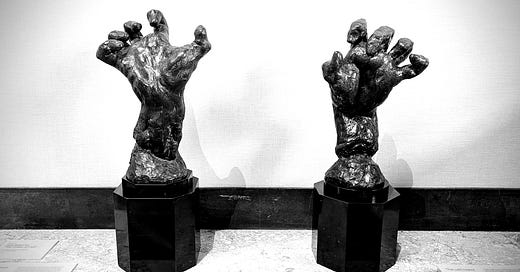Rodin's Hands
In which we talk about Philadelphia, weird mascots and the mangling of extremities.
When I lived in Philly, we didn’t have any fancy Grittys running around – we made due with the Phanatic and we were happy to have it. We did have access to the Philadelphia Museum of Art, the associated Rodin Museum and the Barnes – though it was in a house at the time and also it was like walking into the mind of a madman. I never ended up visiting the Rodin, except to see the pieces outside in the garden.
In Philly’s defense, I didn’t actually live “in” Philadelphia so much as in Bryn Mawr, which is like living in San Mateo and complaining about living in San Francisco. I also didn’t really like going into the city, because I usually drove. Also I just didn’t care for the place. Sorry, I guess.
I’ve since reconnected with Philadelphia through an annual trip to PAX Unplugged. I stay down near Rittenhouse and spend about as much time wandering the city as I do at the convention. This year, because I’ve been enjoying Rodin so much, I made a trip over to the Rodin Museum. Spoiler alert – it’s excellent.
The museum currently has a special exhibit on Rodin’s hands. Not his hands, like the ones that popped out of his sleeves, but the hands he sculpted. They range in size and complexity, from the small, pudgy, plaster hands of children to large, tortured, bronze hands. A good mix of hands-for-hands-sake and hands-as-part-of-larger-works fills the museum’s main room.
Rodin used hands in his pieces like a chef uses spices. Often, they highlight other parts or emotions being expressed. In Saint John the Baptist Preaching, John’s right hand is outstretched just enough to show that the saint is in the middle of presenting something. A gesture that large would never go over in a personal conversation, but it’s not so grand as to be a caricature of movement.
In other cases, the hands become a focal point. I Am Beautiful, a smaller piece from the Gates of Hell, depicts a man holding a crouching woman. The man’s body and muscles strain with the effort of holding her, but all that effort and tension is drawn to a point in the man’s hand on her backside. The hand is the highlight and the central point and the tense feeling of the strain it must be under explains the sculpture in an instant.
Sorry, I had to pause to restart the fire in the fireplace. You might not have noticed, but that’s a little peek behind the curtain.
I think it would be fair to say that Rodin had something like a grotesque understanding of the human body. He had a flair for exaggerating hands, faces, gestures and bodies in ways that pushed the right up to their reasonable limits without breaking.
In Rodin’s The Burghers of Calais, larger than life hands and anguished movements bring life and feeling to the piece. There’s, in some ways, nothing realistic about the interpretation. The bodies and movements would be horrifying to see in real life. In his composition, though, you almost don’t notice until you start looking for them. Everything that’s twisted seems “right”.
Imagine being able to do the opposite of what cantilevered buildings do. When you see something cantilevered, it sticks out into the air and makes you wonder what kind of physics trick must be involved to allow such a thing. It draws attention to itself for being unnatural. Rodin hides his diversions from reality in a way that makes them seem more normal than reality itself. After you look at The Burghers a few times, it seems ludicrous that they would ever have realistically sized hands.
The entire Rodin’s Hands exhibit shows off that skill.
In addition to the pieces I’ve already mentioned, highlights include The Helmet-Maker’s Wife and its parallel or counterpart or mirror, Youth Triumphant. Two pieces mulling the passage of time and its impact on the body and soul. Sad and terrifying and beautiful all at once.
The Clenched Hand and The Left Hand – shown at the top of this post – are displayed next to each other, showing off how far metallic sinew and bone can be twisted while still maintaining their recognizability.
While neither grand nor even a finished piece, there’s a little side project labeled “Assemblage of Heads of ‘The Burghers of Calais’” that’s amazing. It’s a pile of small plaster heads and hands with an angel draped over them. Apparently Rodin would get kinda bored on the weekends and pull a bunch of his bits and pieces together to make these circus sideshow collections. That sounds like a goof, but it’s totally true.
You read the spoiler earlier, but here it is again – Rodin’s Hands is worth a visit. It’s only on for a few more weeks – through January 4, 2025 – so you’ll need to act fast while the offer is still good. Even if you miss it, the pieces on display as part of the permanent collection are worth the trip. It’s a small place and you can be in and out fairly quickly, but there are also sitting areas, sketchbooks and actual books to indulge in, so spending an entire afternoon isn’t out of the question.
Gritty only has four fingers. I wonder which ones the guy in the suit has to double up to make it work. Talk about things pushed to the edge of madness, look at that thing. Sheer terror. Also, someone made a Grittney – wow.







